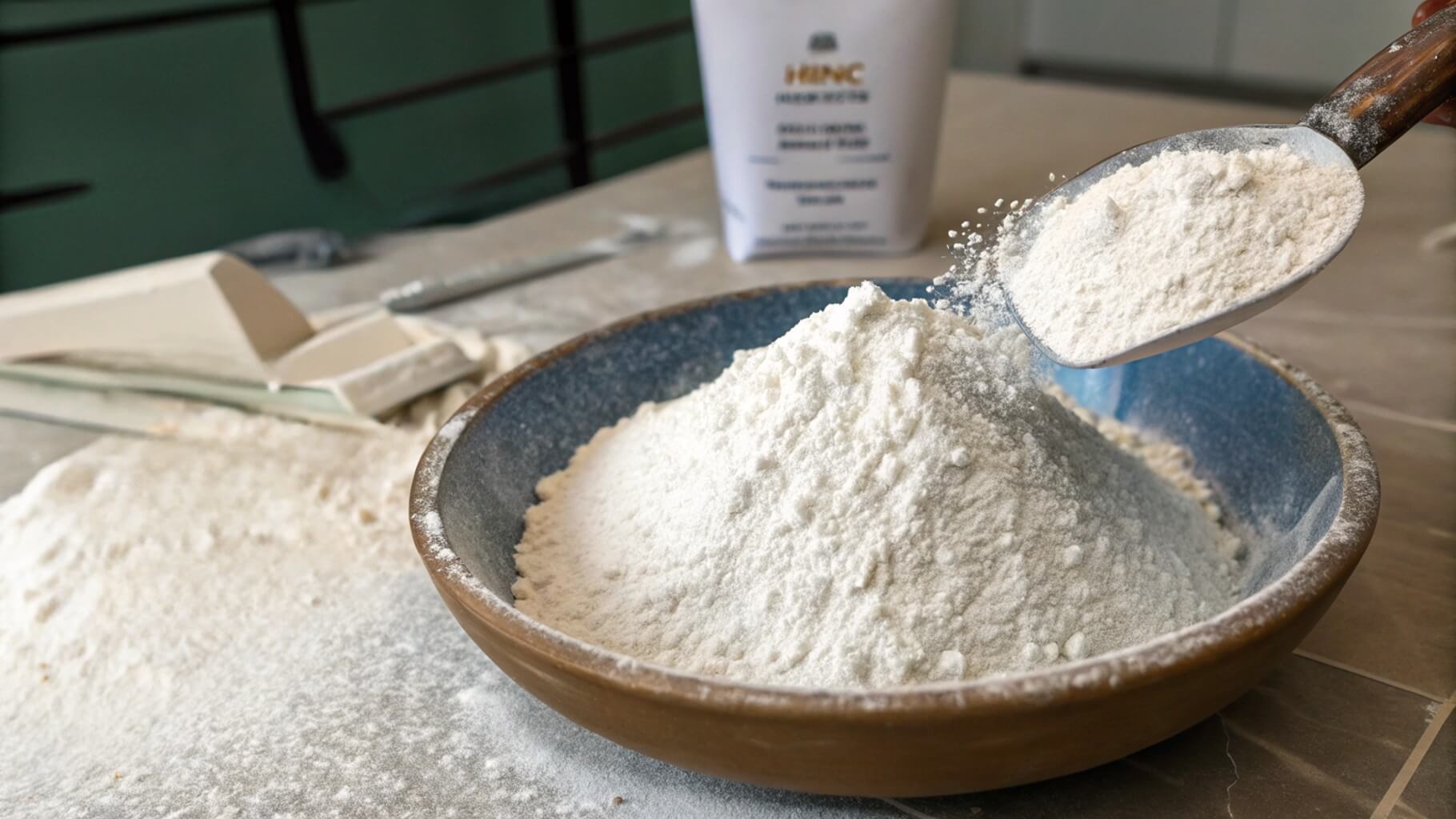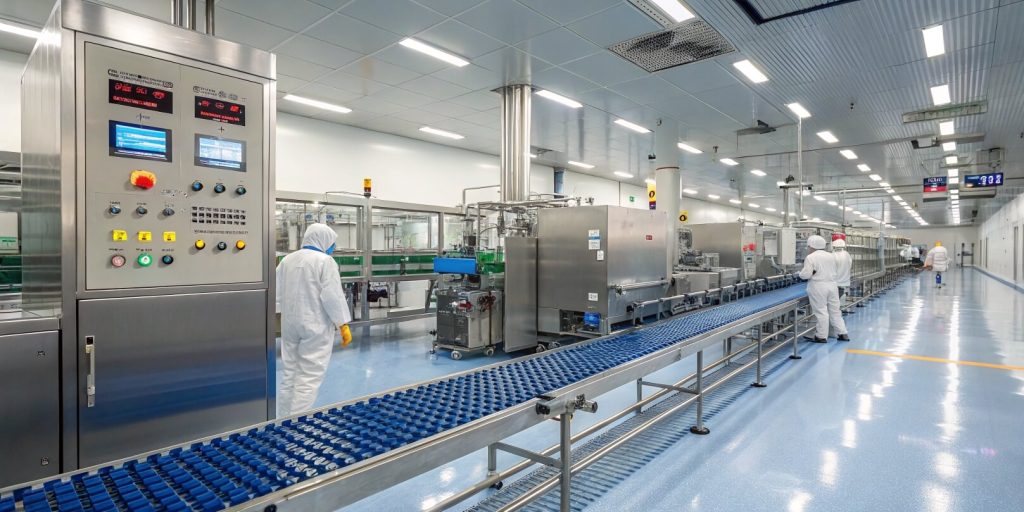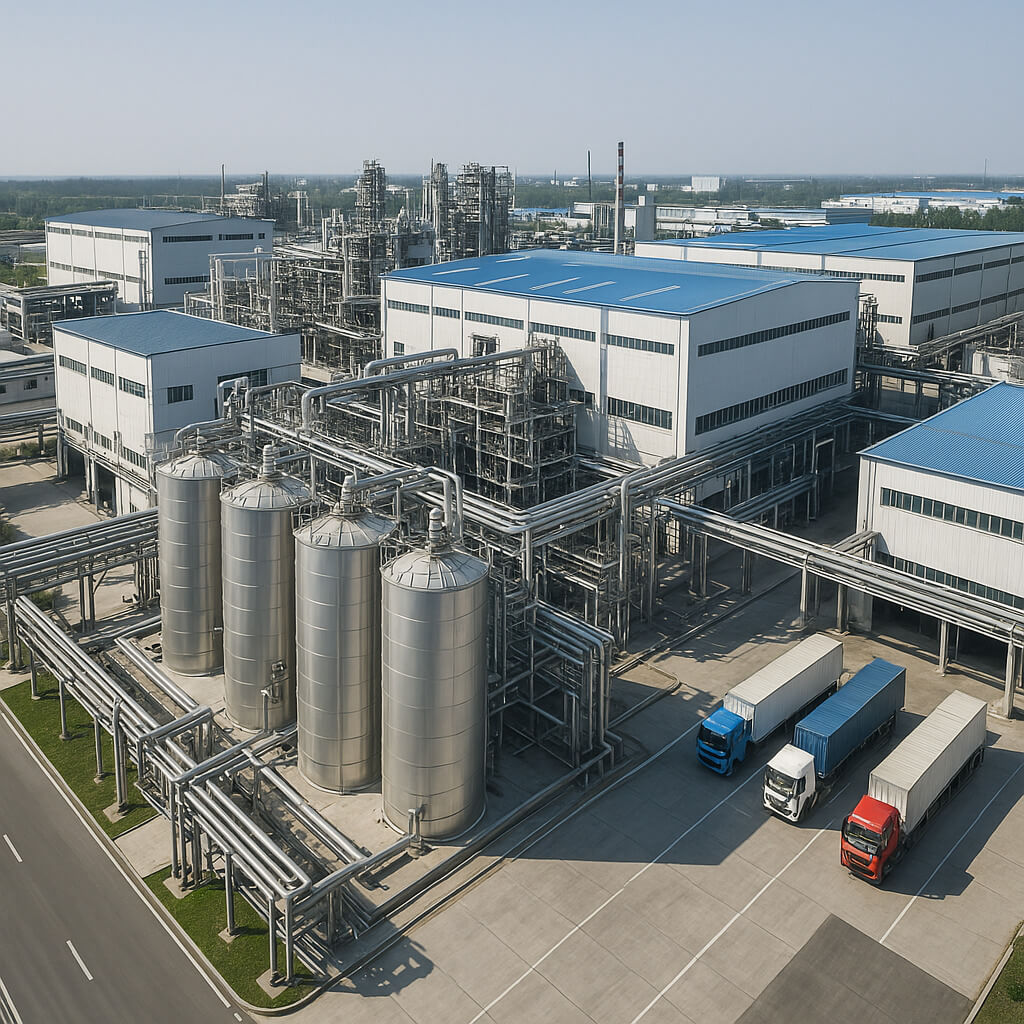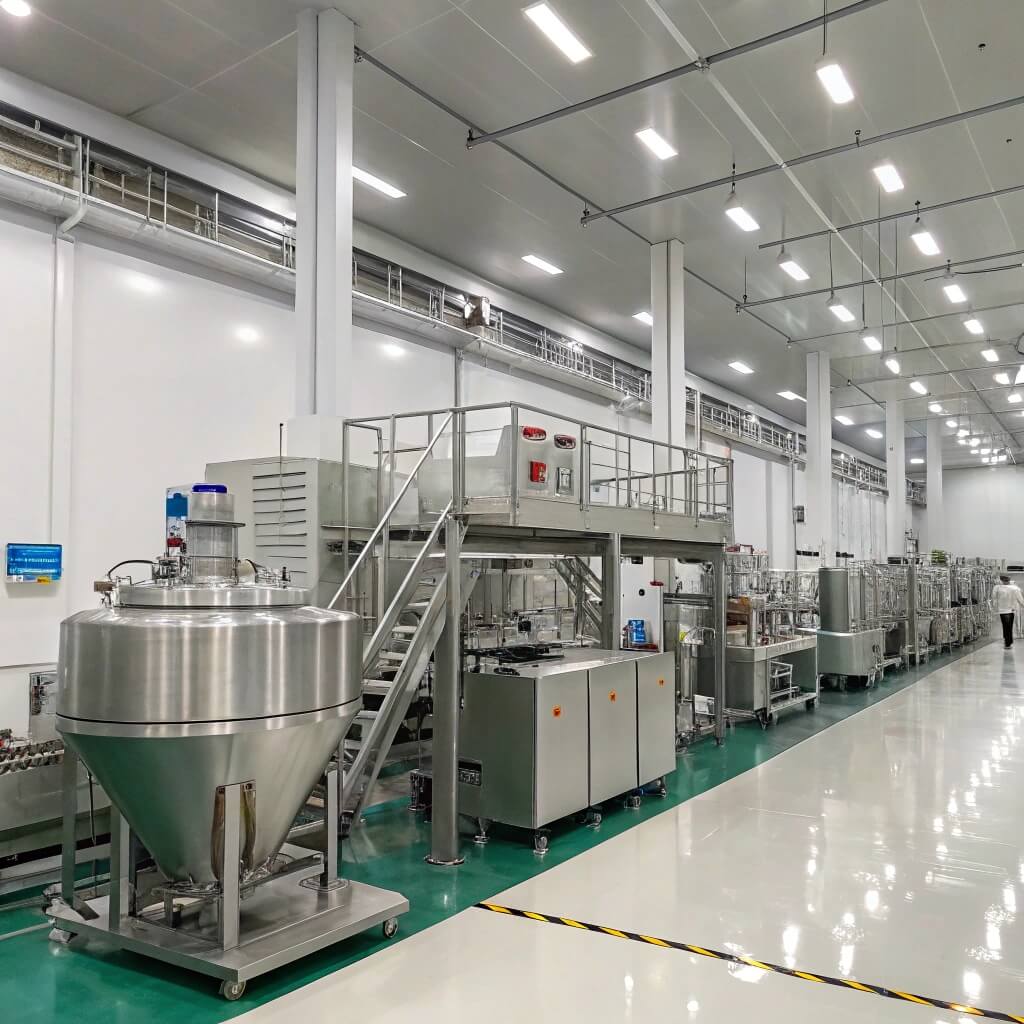Incorrectly mixing HPMC into tile adhesive can lead to inconsistent viscosity, poor workability, and weak bonding strength. Many installers and manufacturers struggle with achieving the right dispersion, resulting in performance issues. Without a proper mixing process, the benefits of HPMC are significantly reduced.
Properly integrating HPMC into tile adhesive ensures optimal water retention, improved adhesion, and enhanced workability. By following the correct mixing techniques, users can maximize efficiency, prevent material waste, and ensure a stable, long-lasting bond between tiles and substrates.

Achieving uniform dispersion of HPMC in tile adhesive enhances consistency, strength, and application efficiency.
To achieve high-performance tile adhesive, understanding the correct HPMC mixing process is essential. The following sections explain why proper mixing matters, the best dispersion techniques, and step-by-step instructions for ensuring effective integration.
Why Is Properly Mixing HPMC Important for Tile Adhesive Performance?
Improperly mixed HPMC in tile adhesive can lead to inconsistent viscosity, poor adhesion, and reduced workability. If not evenly dispersed, the adhesive may develop lumps, settle unevenly, or fail to retain water effectively. This results in weak bonding strength, increased drying time, and application difficulties.
Properly mixing HPMC ensures uniform dispersion, optimizing water retention, adhesion, and workability. It prevents clumping, enhances consistency, and ensures that the adhesive performs reliably across different application conditions.
The Role of Proper HPMC Mixing in Tile Adhesive
Mixing HPMC correctly allows it to interact fully with water and cement components, stabilizing the adhesive mixture. Poor dispersion can lead to performance failures, affecting tile placement and long-term durability.
| Mixing Factor | Impact sur les performances de l'adhésif pour carrelage |
|---|---|
| Rétention d'eau | Prevents premature drying and ensures proper cement hydration. |
| Adhesive Consistency | Creates a smooth, lump-free mixture for easier application. |
| Force de liaison | Enhances adhesion between tiles and substrate. |
| Open Time Stability | Maintains workability for an extended period. |
How Proper HPMC Mixing Improves Tile Adhesive
- Ensures Even Hydration – Proper dispersion allows HPMC to absorb water uniformly, preventing dry spots and uneven curing.
- Prevents Lumping – Correct mixing techniques eliminate clumps, ensuring a smooth and homogeneous adhesive consistency.
- Optimizes Rheology – Improves viscosity, making the adhesive easier to spread and apply.
- Enhances Structural Integrity – Stabilizes the adhesive matrix, preventing shrinkage and cracks during curing.
- Increases Efficiency – Reduces material waste by ensuring consistent performance across batches.
The Risks of Improper Mixing
Incorrectly mixing HPMC with tile adhesive can cause:
- Lumps and Inconsistencies – Uneven distribution affects adhesive texture and performance.
- Reduced Adhesion Strength – Poor dispersion weakens bonding capability.
- Temps d'ouverture raccourci – The adhesive dries too quickly, limiting workability.
- Difficult Application – Increased trowel drag makes spreading more labor-intensive.
By following correct mixing procedures, tile adhesive manufacturers and installers can ensure superior product performance, better application efficiency, and long-lasting tile installations. The next section explores the best methods for dispersing HPMC in tile adhesive formulations.
What Are the Best Methods for Dispersing HPMC in Tile Adhesive?
Improper dispersion of HPMC in tile adhesive can lead to clumping, uneven viscosity, and weak bonding performance. If not properly mixed, HPMC may not fully dissolve, reducing its effectiveness in water retention and adhesion. Achieving a uniform blend is critical for optimizing the adhesive’s performance.
The best methods for dispersing HPMC in tile adhesive involve pre-mixing techniques, proper sequence of ingredient addition, and controlled mixing speeds. These ensure even distribution, prevent lump formation, and maximize the functional benefits of HPMC.
Key Methods for Effective HPMC Dispersion
To fully activate the properties of HPMC, it must be evenly distributed throughout the adhesive mixture. The following techniques help achieve optimal dispersion:
| Méthode | Effect on HPMC Dispersion |
|---|---|
| Dry Blending | Ensures even distribution before water is added. |
| Gradual Hydration | Prevents lumping by allowing controlled absorption. |
| High-Speed Mixing | Enhances dissolution and prevents particle aggregation. |
| Premixing with Cold Water | Facilitates swelling for better dispersion. |
Best Practices for Dispersing HPMC
- Pre-Mix HPMC with Other Dry Components – Before adding water, blend HPMC with cement and sand to distribute it evenly throughout the mixture.
- Use Cold Water for Initial Hydration – HPMC dissolves more effectively in cold water; allowing it to hydrate gradually before adding warm water prevents clumping.
- Add Water Gradually – Slowly introduce water while continuously mixing to ensure uniform distribution.
- Use a High-Speed Mixer – Proper mechanical agitation helps break down any remaining clumps and ensures complete dispersion.
- Allow Full Hydration Time – Let the mixture sit for a few minutes before final blending to enable HPMC to reach its optimal viscosity.
Mistakes to Avoid in HPMC Dispersion
Failing to follow proper dispersion techniques can lead to:
- Clumping Issues – Poorly mixed HPMC forms lumps, reducing its effectiveness.
- Inconsistent Adhesive Properties – Unevenly distributed HPMC results in variable viscosity and workability.
- Poor Bonding Strength – Weak dispersion can cause adhesion failures.
- Wasted Material – Inefficient mixing leads to product losses and inconsistent batch quality.
By applying these best dispersion methods, manufacturers and installers can ensure that HPMC integrates seamlessly into tile adhesives, maximizing its benefits. The next section explores the correct mixing ratio of HPMC for achieving optimal performance.
What Is the Correct Mixing Ratio of HPMC in Tile Adhesive?
Using too much or too little HPMC in tile adhesive can negatively impact workability, adhesion strength, and water retention. An incorrect ratio may lead to poor bonding, excessive drying times, or sagging tiles. Achieving the right balance is essential for optimizing performance.
The correct mixing ratio of HPMC in tile adhesive typically ranges from 0.2% to 0.6% by weight, depending on the formulation, tile type, and environmental conditions. This ensures proper viscosity, extended open time, and enhanced adhesion without compromising application efficiency.
Recommended HPMC Ratios for Different Tile Adhesives
The ideal HPMC concentration varies based on adhesive composition and intended application. Below is a guideline for typical formulations:
| Type d'adhésif | HPMC Percentage | Performance Benefits |
|---|---|---|
| Standard Cement-Based | 0.2% - 0.4% | Improves adhesion, prevents premature drying. |
| High-Performance Polymer-Modified | 0.4% - 0.6% | Enhances flexibility, reduces shrinkage. |
| Large-Format Tile Adhesive | 0.4% - 0.5% | Increases open time, prevents sagging. |
| Fast-Setting Tile Adhesive | 0.3% - 0.5% | Controls drying speed, improves workability. |
Factors Affecting the Ideal HPMC Ratio
- Cement Composition – Higher cement content may require a slightly increased HPMC percentage for better hydration control.
- Type et taille des carreaux – Large tiles need enhanced workability and open time, requiring slightly higher HPMC content.
- Application Environment – Hot or dry conditions necessitate improved water retention, often requiring a slightly higher ratio.
- Additional Modifiers – If polymer additives are included, the HPMC ratio may need adjustment to balance viscosity.
Risks of Incorrect HPMC Ratios
Using an improper HPMC concentration can lead to:
- Excessive Water Retention – Too much HPMC can slow down curing time, affecting efficiency.
- Reduced Adhesion Strength – Insufficient HPMC may lead to weak bonding and tile detachment.
- Difficult Application – Overuse can make the adhesive too thick, increasing trowel drag.
- Shrinkage and Cracking – Inconsistent ratios can affect drying properties, leading to structural issues.
By carefully measuring and adjusting the HPMC ratio, tile adhesive manufacturers and installers can achieve the best balance of adhesion, flexibility, and durability. The next section provides a step-by-step guide on how to mix HPMC with tile adhesive for optimal results.
Step-by-Step Guide: How to Mix HPMC with Tile Adhesive?
Incorrectly mixing HPMC with tile adhesive can cause lumping, uneven dispersion, and reduced bonding strength. Without proper integration, the adhesive may not perform as expected, leading to weak adhesion and poor workability. A structured mixing process[^1] ensures uniform consistency and optimal application results.
[^1]: Learning about structured mixing processes can improve your adhesive application techniques for better results.
Following a precise step-by-step method guarantees proper HPMC dispersion, enhancing water retention, adhesion, and overall workability. This guide outlines the best practices to achieve a smooth and effective tile adhesive mixture.
Step-by-Step Instructions for Mixing HPMC with Tile Adhesive
| Étape | Procedure | Raison |
|---|---|---|
| 1 | Pre-mix HPMC with dry ingredients (cement, sand, fillers). | Prevents clumping and ensures even distribution. |
| 2 | Use clean, cold water in a mixing container. | Helps control the hydration rate of HPMC. |
| 3 | Gradually add the dry mixture to the water while stirring. | Reduces the risk of lump formation. |
| 4 | Use a mechanical mixer at a low speed (300-500 rpm). | Ensures even dispersion and smooth consistency. |
| 5 | Allow the mixture to sit for 5-10 minutes. | Enables full hydration and viscosity development. |
| 6 | Re-mix briefly before application. | Guarantees uniform texture and optimal workability. |
Best Practices for Achieving a Consistent Mix
- Pre-blend HPMC with Cement and Sand – Dry mixing prevents localized clumps and ensures better integration.
- Control Water Addition – Pouring water gradually while mixing prevents dry spots and improves consistency.
- Use Mechanical Mixing – Hand mixing is not sufficient for uniform dispersion; a mechanical mixer enhances efficiency.
- Observe Hydration Time – Letting the mixture rest before final blending ensures that HPMC fully activates.
- Adjust Mixing Speed as Needed – Avoid excessively high speeds, which can introduce air bubbles and weaken the adhesive.
Common Issues and How to Fix Them
- Lumps in the Mixture → Ensure HPMC is dry-mixed with other ingredients before adding water.
- Adhesive Dries Too Fast → Increase the HPMC content slightly to enhance water retention.
- Poor Spreadability → Verify the water-to-adhesive ratio and adjust mixing time.
- Inconsistent Texture → Always remix the adhesive before application to maintain uniformity.
By following these structured mixing steps, users can achieve a high-performance tile adhesive with excellent adhesion, workability, and durability. The next section explores how to optimize HPMC performance across different tile adhesive applications.
How to Optimize HPMC Performance in Different Tile Adhesive Applications?
Different tile adhesive applications require specific performance characteristics. Using the same HPMC formulation across all projects may lead to suboptimal adhesion, workability issues, or durability concerns. Adjusting HPMC properties based on adhesive type ensures consistent, high-quality results.
Optimizing HPMC performance involves adjusting viscosity, concentration, and mixing techniques based on tile size, substrate type, and environmental conditions. Tailoring the formulation enhances adhesion, water retention, and flexibility for various tile adhesive applications.
HPMC Optimization Strategies for Different Tile Adhesives
| Type d'application | Recommended HPMC Adjustments | Principaux avantages |
|---|---|---|
| Standard Floor Tile Adhesive | Medium-viscosity HPMC (0.2%-0.4%) | Balanced workability and adhesion strength. |
| Large-Format Tile Adhesive | Higher-viscosity HPMC (0.4%-0.5%) | Improved sag resistance and extended open time. |
| Fast-Setting Adhesive | Lower HPMC content (0.3%-0.4%) | Accelerates curing while maintaining workability. |
| Outdoor/High-Moisture Areas | Modified HPMC with enhanced water retention | Prevents premature drying and enhances durability. |
Key Factors Affecting HPMC Optimization
- Tile Size and Weight – Large tiles require a more viscous adhesive to prevent slippage.
- Conditions environnementales – Hot and dry climates need higher water retention for extended workability.
- Substrate Absorption – Highly porous surfaces may require increased HPMC content to maintain moisture balance.
- Curing Time Requirements – Fast-setting applications benefit from a lower HPMC concentration to maintain efficiency.
Best Practices for Maximizing HPMC Effectiveness
- Test Small Batches First – Adjust HPMC levels based on initial results before large-scale production.
- Modify Mixing Ratios for Extreme Conditions – Increase water retention properties in hot or dry environments.
- Ensure Proper Dispersion – Follow correct mixing techniques to prevent clumping and viscosity inconsistencies.
- Adjust Open Time for Large Projects – Higher HPMC viscosity provides more flexibility for large tile installations.
By tailoring HPMC formulations to specific tile adhesive applications, manufacturers and installers can achieve optimal bonding strength, workability, and long-term durability. The next section highlights common mistakes to avoid when mixing HPMC with tile adhesive.
Common Mistakes to Avoid When Mixing HPMC with Tile Adhesive?
Improper mixing of HPMC can lead to poor dispersion, weak adhesion, and inconsistent performance. Many users unknowingly make mistakes that reduce the effectiveness of HPMC, causing application challenges and long-term durability issues. Understanding these common errors helps prevent costly installation failures.
Avoiding common mixing mistakes ensures that HPMC fully integrates into the tile adhesive, optimizing water retention, adhesion, and workability. Proper techniques improve efficiency, reduce material waste, and enhance overall performance.
Frequent Mistakes and How to Fix Them
| Mistake | Cause | Solution |
|---|---|---|
| Adding HPMC Directly to Water | HPMC clumps when exposed to water too quickly. | Pre-mix with dry ingredients before adding water. |
| Using Excessive Mixing Speed | High-speed mixing traps air, reducing adhesion. | Keep mixing speed moderate (300-500 rpm). |
| Skipping Hydration Time | HPMC needs time to absorb water and develop viscosity. | Let mixture sit for 5-10 minutes before final mixing. |
| Incorrect HPMC Ratio | Too much or too little HPMC affects consistency. | Follow recommended HPMC percentages based on adhesive type. |
| Uneven Dispersion | HPMC is not evenly distributed within the dry mix. | Blend thoroughly with cement and fillers before adding water. |
How to Ensure Proper Mixing
- Pre-Mix HPMC with Dry Components – Dry blending prevents lump formation and ensures even distribution.
- Gradually Add Water While Stirring – Pouring water slowly while mixing improves consistency.
- Use the Right Mixing Equipment – Mechanical mixers enhance dispersion and prevent inconsistencies.
- Allow Adequate Hydration Time – Giving the mixture time to rest ensures full viscosity development.
- Re-Mix Before Application – Stirring again before use guarantees uniform texture and adhesion strength.
Consequences of Poor Mixing
Failing to follow proper techniques can result in:
- Lumps in the Mixture – Leads to uneven application and inconsistent adhesive strength.
- Reduced Open Time – Poor water retention causes premature drying.
- Weak Bonding – Improper dispersion lowers adhesion between tile and substrate.
- Difficult Application – Increased trowel resistance makes spreading more labor-intensive.
By avoiding these common mistakes, users can ensure that HPMC enhances the quality and durability of tile adhesives. The final section summarizes the key steps for achieving the best HPMC integration in tile adhesive formulations.
Conclusion: How to Achieve the Best HPMC Integration in Tile Adhesive?
The quality of tile adhesive depends heavily on how well HPMC is integrated. Poor mixing techniques can lead to clumping, inconsistent viscosity, and weak adhesion, reducing the effectiveness of the adhesive. Ensuring proper dispersion is critical for achieving optimal bonding strength, workability, and long-term durability.
To achieve the best HPMC integration, users must follow structured mixing procedures, use the correct HPMC ratio, and apply best practices for dispersion. Properly mixed HPMC enhances water retention, extends open time, and ensures a stable, easy-to-apply adhesive formulation.
Key Takeaways for Optimal HPMC Performance:
- Correct Mixing Ratio – Use 0.2% - 0.6% HPMC based on adhesive type and environmental conditions.
- Proper Dispersion Techniques – Pre-mix HPMC with dry ingredients before adding water to prevent clumping.
- Controlled Mixing Process – Use a mechanical mixer at moderate speed and allow hydration time before final blending.
- Application-Specific Adjustments – Modify HPMC content based on tile size, substrate absorption, and climate conditions.
By following these steps, manufacturers and tile installers can maximize the benefits of HPMC, ensuring high-quality adhesive performance. For those looking to refine their formulations or improve production efficiency, expert guidance on HPMC integration can make a significant difference. Contact us today to explore tailored solutions for your tile adhesive needs.
FAQ
How do you mix HPMC?
To mix HPMC properly, first pre-blend it with dry ingredients like cement and sand. Gradually add water while continuously stirring to prevent clumping. Use a mechanical mixer at 300-500 rpm for uniform dispersion. Allow the mixture to sit for 5-10 minutes before final blending to ensure full hydration and viscosity development.
Quelle est l’utilisation du HPMC dans les colles à carrelage ?
HPMC improves tile adhesive performance by enhancing water retention, increasing adhesion strength, extending open time, and improving workability. It prevents premature drying, ensures proper cement hydration, and provides anti-slip properties, making installation easier and more durable.
Quel est le rapport de mélange pour la colle à carrelage ?
Le HPMC mixing ratio in tile adhesive typically ranges from 0.2% to 0.6% by weight, depending on the adhesive type and application. Standard cement-based adhesives use 0.2%-0.4%, while large-format or high-performance adhesives may require 0.4%-0.6% for improved workability and bonding strength.
Can you mix bonding liquid with tile adhesive?
Oui, bonding liquids can be mixed with tile adhesive to enhance flexibility and adhesion, particularly for surfaces non poreuses or high-moisture environments. However, when using HPMC in the formulation, the ratio of bonding liquid must be adjusted to maintain the correct viscosity and workability.




